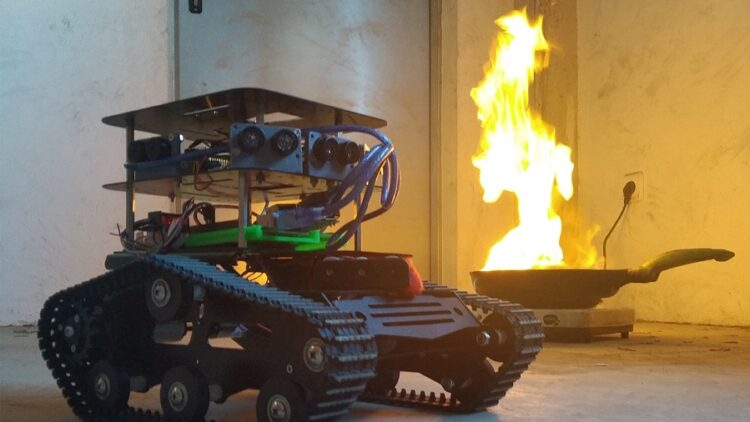It’s a high-tech answer to an increasingly urgent problem. But as interest in robotic solutions grows, so does a quieter but critical concern: Where are these machines really made? And how can first responders—and the governments funding them—be sure that what’s being delivered is what was promised?
The rise of fire-response robots comes with a logistical and ethical challenge that could define the future of the sector: traceability. As demand accelerates, buyers are discovering that origin, transparency, and accountability matter as much as performance in the field.
The Opportunity: A Market on Fire
The global market for robotics in emergency response is on an explosive trajectory. According to Allied Market Research, the fire-fighting robot market is projected to reach $2.3 billion by 2032, up from $1.2 billion in 2022. Much of this growth is driven by government procurement programs aiming to modernize fire departments and civil defense units.
These machines are no longer limited to demonstrations at defense expos. Real-world deployments are happening now: from tunnel fires in Italy to refinery emergencies in the Middle East. They come in many forms—tracked vehicles equipped with high-pressure hoses, aerial drones for surveillance, and compact autonomous units designed to navigate confined industrial spaces.
The potential is enormous: saving lives, reducing firefighter exposure, and enabling smarter fireground strategies. But with opportunity comes complexity—and risk.
Must Read: https://tododisca.com/
What’s Inside the Box?
Despite their appearance on the most advanced firegrounds, many firefighting robots are not fully developed in the country where they are sold. The fire-tech industry is rife with “white label” equipment—OEM (original equipment manufacturer) robots designed in one country, manufactured in another, and rebranded by distributors in a third.
This practice is common in consumer electronics. But in public safety, it raises hard questions. When a fire service invests hundreds of thousands of dollars into a robot platform, they need assurance not just that it works—but that someone will be accountable if it doesn’t.
And yet, in many cases, even experienced procurement officers can’t say with confidence where a given robot was made, what quality control standards apply, or who actually owns the intellectual property.
“Sometimes it’s easier to buy a $200,000 robot than to trace where it came from,” notes one civil protection adviser in Brussels, speaking on background. “The branding looks European. The components don’t.”
Rebranding and the Illusion of Local Design
The lack of transparency isn’t just a supply chain issue—it’s also a marketing one.
Many distributors present their fire-response robots as locally engineered solutions, emphasizing domestic support, training, and servicing. But dig into the data sheets, and things often become murky. Critical components—motors, battery systems, thermal cameras—may be sourced from multiple continents. The robot itself may be assembled in an offshore factory with little or no oversight from the seller.
This blurring of origin matters. It affects not just procurement integrity but also ongoing maintenance, long-term compatibility, and the availability of spare parts. If a robot fails during a critical mission, who is responsible? The distributor? The assembler? The unknown third-party supplier?
JCM Distribution, a French supplier of equipment to fire and rescue services offers for example several models of firefighting robots—such as the Rover, Trypper, and MRX—which are actually manufactured by COBRA-I, a robotics firm based in China (also known as FOUROBOT). The equipment reportedly passes through a distributor in Italy before arriving in France, rebranded and marketed to domestic clients. There’s nothing illegal about this business model, but in a context as sensitive as firefighting—where reliability, maintenance, and rapid parts replacement are critical—it creates uncertainty for buyers.
The Consequences of Opaque Procurement
Governments are starting to notice. In a 2023 report on public procurement risk, the OECD warned that “low-visibility supply chains in safety-critical sectors pose a non-negligible threat to service continuity and accountability.”
For fire departments, the stakes are not theoretical. A robot purchased from a distributor without clear maintenance capabilities may become unusable if even one component fails—and can’t be replaced promptly.
This issue is particularly acute in the case of long-term service contracts. If a machine has no verifiable manufacturing trail, then scaling upgrades, integrating software updates, or replacing batteries after three years becomes a logistical nightmare.
A Story of Discontinuity—on Paper Only
Traceability issues don’t just stem from imports. Sometimes they originate domestically, through legal but ethically questionable reconfigurations of corporate identity.
In 2018, a French company called TECDRON won a public tender from the Préfecture de Police de Paris to deliver firefighting robots. During the evaluation process, technical teams from the Paris Fire Brigade found significant discrepancies between what was promised and what was delivered. The robot underperformed, and some of the specs in the bid were flagged as misleading.
The result: TECDRON’s offer was rejected. The government requested a refund and issued a formal notice of false declaration, triggering a three-year obligation to disclose the incident in all future public tenders—a red flag in any competitive bidding process.
Soon after, TECDRON was dissolved. But within weeks, a new company emerged: ANGATEC. It featured the same leadership, a nearly identical robot (renamed from TC800 to TEC800), and even reused commercial visuals and promotional materials from its predecessor. It also began bidding on new public opportunities.
While this maneuver may not breach French commercial law, it poses clear challenges to procurement integrity. Buyers faced with ANGATEC’s proposals were not necessarily aware they were dealing with the same actors, offering the same product, that had previously failed official tests.
A Case for Certification and Labels
To address the problem, industry leaders are calling for new frameworks that prioritize traceability and verification, not just performance metrics.
One proposed solution is a European or international certification label for fire-response robotics—akin to a UL listing or ISO certification—that would validate not only functional testing, but also component origin, warranty structure, and support infrastructure.
Such a system would help differentiate between engineering firms genuinely invested in the technology and distributors operating on a drop-ship model with minimal accountability.
Another idea: mandatory origin disclosure clauses in public tenders. Governments could require bidders to detail where their products are designed, assembled, and tested—down to the level of mission-critical parts.
It’s not protectionism. It’s prudence. When human lives depend on machines functioning in lethal environments, transparency isn’t a luxury—it’s a prerequisite.
The Strategic Implications
Beyond performance and procurement, there’s also a geopolitical dimension to consider. Many firefighting robots rely on components—particularly in sensors and communications—that may be subject to export controls, national security policies, or future regulatory scrutiny.
As defense and civil protection domains converge, nations may start viewing robotic platforms as part of critical infrastructure. The U.S., EU, and several Indo-Pacific states are already moving toward more scrutiny of origin in AI and robotics hardware used in public safety.
Firefighting robots might be the next frontier in this evolution.
The Bottom Line
The firefighting robot sector stands at a crossroads. The technology is advancing. The market is growing. But without clear standards for origin, accountability, and traceability, public trust—and operational reliability—remain at risk.
This is not a call to limit innovation or shut out international suppliers. It’s a call for clarity, standards, and fairness. Because when a fire breaks out, no one should be left wondering whether the robot on the field came with a support plan—or just a sticker.































